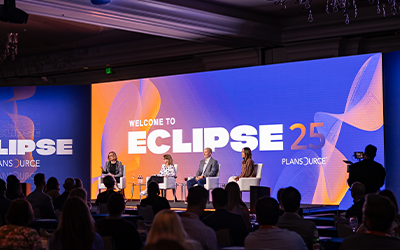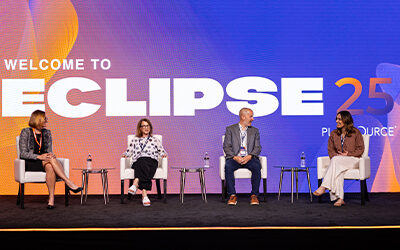The traditional workforce is going through somewhat of a renaissance as the term ‘traditional’ is quickly changing. Remote work is slowly becoming the new norm as employers look to meet the demands of a modern, diverse, multi-generational workforce.
Over the past decade, remote work has become far more common thanks to advances in communication technology and internet access. In fact, remote work has grown over 140% since 2005, which is nearly 10 times faster than the rest of the workforce. And the demand is there, with 80% of eligible workers indicating that they would like the opportunity to work remote at least part-time.
There are several pros and cons to consider when building out a remote workforce, and engagement is one of the primary pain points for HR teams and managers. Engagement is especially critical during open enrollment, which also happens to be one of the busiest times of the year for HR. It’s often difficult to get on-site workers to remain engaged during OE, so it’s not hard to imagine why keeping remote workers in the loop could be a challenge.
How can you mimic this same level of education and engagement with your remote teams to ensure they are confident with their benefits decisions?
We’ve got you covered with five specific tactics to engage remote employees before, during and after open enrollment.
1.) Video For Benefits Education
Employees are 75% more likely to watch an entire video than read an entire document. How’s that for engagement? And, studies have also shown that video is a far better educational tool than written text.
To leverage this, create fun, personalized videos for employees rather than long, wordy documents. Incorporate short, educational videos into the benefits shopping experience or use a video postcard to announce important open enrollment deadlines and materials. Videos can also be shared in emails and hosted an on-demand video library for year-round reference. This will help remote employees better understand their benefits and have quick, convenient access no matter the time of day.
Here’s an example of a short video that explains a basic benefits concept—HSAs.
Visit our full benefits video library for access to FREE educational videos.
2.) Social Media For Conversations
More and more people are active on social media, and the average person spends more than 90 minutes per day on social media; take advantage of this and meet your employees where they are by creating new and convenient communication channels.
Facebook and LinkedIn support private groups, which can be a great way to keep the communication channel open and share important dates and materials. Just remember that social media is meant for socializing, so be sure to follow social media best practices to ensure your communications are valuable and relevant.
3.) Email Campaigns For Reference
Tried and true, email is still one of the most effective ways to communicate with employees—especially remote workers. Quick, convenient and expected, email should definitely be a large part of your open enrollment communications strategy.
Begin with company-wide communications to all benefits-eligible employees that cover the basics: OE dates, required materials, login information, etc. You can also send a few follow-up emails that cover open enrollment best practices, information on any informational sessions and links to any benefits guides or educations materials.
From there, segment out your workforce and send customized messages to employees that have not completed enrollment to remind them of the upcoming deadline.
If you have a large remote workforce, create a specific segment just for remote employees and customize the messaging and follow up accordingly.
Finally, be sure to use email best practices to ensure your emails are seen and read.
Despite email’s many advantages—it’s important to also keep in mind a few potential pitfalls.
First, many desk employees send and receive over 200 emails per day, so it can be easy for HR announcements to get buried. For remote employees specifically, keep in mind that many might be in different time zones, so email is not the best place for red hot, time-sensitive communications—like a last-minute reminder on the final day of OE. Additionally, not every employee has a company email or has easy access to a computer, so consider your unique workforce dynamic and incorporate other channels into your overall communications strategy.
Check out these free open enrollment email templates to get started.
4.) Text Message Alerts For Reminders
Many managers assume that employees do not want to receive text message alerts from businesses—but that’s not necessarily the case, and the data definitely supports using texting for company communications.
82% of text messages are read within five minutes, and 78% of consumers say that text is the fastest way to reach them for important updates. The high open rate of text messages is reason enough to consider adding this tactic into your communications tool box.
Like email, text message alerts can easily be segmented into specific groups, allowing you to easily message all benefits-eligible employees with reminders about OE dates and materials and then begin to filter the list down to just employees that have not yet completed enrollment.
The only caveat? Text message alerts are opt-in, meaning that employees must consent to receive communications. However, the research shows that employees don’t mind receiving messages as long as they aren’t intrusive.
To make the most of text alerts and to increase your opt-in rate, keep your messages short and simple, and only send alerts for top-priority communications. For remote employees specifically, be mindful of any time zone differences and schedule messages during an appropriate time; avoid after-hours or late-night messages.
5.) Remote Meetings For Q&A
You probably hold an on-site benefit fair or in-person benefits meetings to go over any plan changes, introduce new benefits and to answer any questions that might arise during the process. In-person events, when well executed, can be an incredibly effective way to engage with and educate employees. So, how can you replicate this same strategy with remote employees?
While you might not be able to travel to your employees’ home to deliver an in-person benefits presentation, technology has made it easier than ever to connect in real time. Schedule a few virtual benefits reviews to give remote employees the same level of attention as your in-office workforce.
This will not only increase engagement during open enrollment but also increase benefits understanding and give remote employees time to ask any questions they have about their benefits or the enrollment process. And, set aside a few time slots for remote employees to request a one-on-one consult for any one-off questions or situations that pop up.
If you are managing a particularly large remote workforce, a benefits contact center could be a great solution to help mitigate and manage questions and concerns during HR’s busiest time of the year. Available on-demand, a remote contact center is a great way to add personalized service and support for your remote employees.
Best Practices To Engage Remote Employees
Here are a few other tips to keep in mind when considering remote employees during open enrollment:
- Explain the basics. It is important to reiterate the basics of open enrollment to employees so they have a better understanding of their benefits—and remote employees are no exception. Offer convenient and engaging educational materials to support remote employees before, during and after open enrollment.
- Host benefits materials in a single, central location. Having benefits materials stored in multiple locations can be confusing and inconvenient. If possible, keep all of your OE information—including benefits guides, FAQ sheets, educational videos and materials, and more—in a single location that you can easily reference in communications and that remote employees can bookmark for later use. This could be hosted on a dedicated benefits website or via an internal server system.
- Make a plan, know your audience and tailor the message. Remote employees are more likely to be engaged during open enrollment if there is a structured, organized plan and if they feel like the message is specialized for them, not just a blast to the masses. Consider the unique challenges of your remote workers and incorporate specific language and programs to address these in your overall OE communication strategy.
When properly managed, remote employees often report higher satisfaction and engagement than employees in a traditional office setting! Make this trend the norm by embracing a robust communication and education strategy that includes all facets of your diverse workforce, including your remote workers.
Check out our free Open Enrollment Planning Playbook for more tips on how to plan, execute and measure your open enrollment.
Want More Benefits Tips & Tools?
Subscribe to our Newsletter to stay up to date with the latest and greatest benefits news, best practices, exclusive offers and more!
Empathy, Innovation & Action: Top Takeaways from HR Leaders Who Spoke at Eclipse
Empathy, Innovation & Action:Top Takeaways from the HR Leaders Who Spoke at...
Charting the Future of PlanSource: Our Vision for What’s Ahead
Discover how PlanSource unveiled game-changing AI innovations at Eclipse 2025, transforming how HR leaders manage benefits and how employees choose them. The future of benefits starts here.
Navigating New Requirements with the Paperwork Burden Reduction Act
Navigating New Requirements with the Paperwork Burden Reduction...




